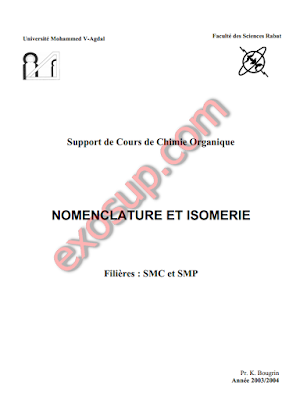Cours de Chimie Organique smp-smc fsr 2003/04
Cours de Chimie Organique smp-smc fsr
Université Mohammed V-Agdal
Faculté des Sciences Rabat
Support de Cours de Chimie Organique
NOMENCLATURE ET ISOMERIE
Filières : SMC et SMP
Pr K. Bougrin
Année 2003/2004
PREFACE
Ce support de cours de chimie organique est destiné aux étudiants inscrits dans le module «Module 8 Chimie Générale II /SMC-SMP ) » du semestre II, des Filière SMP/SMC. Il est conforme au programme de la nouvelle réforme entrée en vigueur depuis 2003. Ce polycopié n’est qu’un complément de cours. Il ne pourra, en aucune façon, dispenser l’étudiant de sa présence en cours.
TABLES DES MATIERES
INTRODUCTION GENERALE
CHAPITRE 1 : NOMENCLATURE ORGUANIQE
I- LES ALCANES
1) GROUPES UNIVALENTS DERIVANT D'UN ALCANE LINEAIRE (NOTION DE RADICAL)
2) ALCANES RAMIFIES
3) CYCLOALKANES
4) COMPOSES AVEC GROUPEMENT FONCTIONNEL MONOVALENT
a) Groupes à Préfixes : Les halogénoalcanes
b) Les Ethers - Oxydes
II- HYDROCARBURES INSATURES LINEAIRES
1) LES ALCENES
2) LES ALCYNES
3) COMPOSES COMPORTANT DES DOUBLES ET DES TRIPLES LIAISONS
III) COMPOSES COMPORTANT UNE OU PLUSIEURS FONCTIONS
(POLYFONCTIONNELS)
a) Amines : Dans la famille des amines on distingue trois types
-Les amines primaires
-Amines secondaires
-Amines tertiaires
b) Les alcools
c) Les Cétones
d) Les Aldéhydes
e) Les Amides
f) Les acides carboxyliques
g) Les esters
IV- COMPOSES AROMATIQUES (BENZENE)
- DERIVES DU BENZENE MONOSUBSTITUES
Chapitre 2 : STEREO-ISOMERIE ET ANALYSE CONFORMATIONNELLE
I- ISOMERIE
1) DEFINITION
2) ISOMERIE DE CONSTITUTION
a) Isomérie de fonction
b) Isomérie de position
c) Isomères de chaîne
II- REPRESENTATION DES MOLECULES DANS L'ESPACE
1) REPRESENTATION EN PERSPECTIVE
2) REPRESENTATION DE NEWMAN
III- STEREOISOMERIE
1) DEFINITION
2) NOTION D'ISOMERES DE CONFORMATION
3) ETUDE CONFORMATIONNELLE DES COMPOSES ACYCLIQUES (ETHANE, BUTANE)
a) Conformations de l’éthane
b) Conformations du butane
4) ETUDE CONFORMATIONNELLE DES COMPOSES CYCLIQUES (CAS DU CYCLOHEXANE)
Chapitre 3 : CONFIGURATION
I) REGLES SEQUENTIELLES DE CAHN, INGOLD ET PRELOG
II) APPLICATIONS DE LA REGLE CIP
1) DETERMINATION DES CONFIGURATIONS (E/Z)
2) DETERMINATION DE LA CONFIGURATION R/S DU CARBONE ASYMETRIQUE)
Chapitre 4 : ISOMERIE OPTIQUE
I) ACTIVITE OPTIQUE
II) CHIRALITE ET ENANTIOMERIE
1) CHIRALITE
a) Définition
b) Condition pratique
2) ENANTIOMERIE
a) Définition
b) Types de composés optiquement actifs
c) Représentation plane Projection de Fischer
d) Molécules contenant plusieurs atomes de carbones asymétriques
e) Cas de molécules symétriquement substituées
f) Configurations absolues D, L
Télécharger
Université Mohammed V-Agdal
Faculté des Sciences Rabat
Support de Cours de Chimie Organique
NOMENCLATURE ET ISOMERIE
Filières : SMC et SMP
Pr K. Bougrin
Année 2003/2004
PREFACE
Ce support de cours de chimie organique est destiné aux étudiants inscrits dans le module «Module 8 Chimie Générale II /SMC-SMP ) » du semestre II, des Filière SMP/SMC. Il est conforme au programme de la nouvelle réforme entrée en vigueur depuis 2003. Ce polycopié n’est qu’un complément de cours. Il ne pourra, en aucune façon, dispenser l’étudiant de sa présence en cours.
TABLES DES MATIERES
INTRODUCTION GENERALE
CHAPITRE 1 : NOMENCLATURE ORGUANIQE
I- LES ALCANES
1) GROUPES UNIVALENTS DERIVANT D'UN ALCANE LINEAIRE (NOTION DE RADICAL)
2) ALCANES RAMIFIES
3) CYCLOALKANES
4) COMPOSES AVEC GROUPEMENT FONCTIONNEL MONOVALENT
a) Groupes à Préfixes : Les halogénoalcanes
b) Les Ethers - Oxydes
II- HYDROCARBURES INSATURES LINEAIRES
1) LES ALCENES
2) LES ALCYNES
3) COMPOSES COMPORTANT DES DOUBLES ET DES TRIPLES LIAISONS
III) COMPOSES COMPORTANT UNE OU PLUSIEURS FONCTIONS
(POLYFONCTIONNELS)
a) Amines : Dans la famille des amines on distingue trois types
-Les amines primaires
-Amines secondaires
-Amines tertiaires
b) Les alcools
c) Les Cétones
d) Les Aldéhydes
e) Les Amides
f) Les acides carboxyliques
g) Les esters
IV- COMPOSES AROMATIQUES (BENZENE)
- DERIVES DU BENZENE MONOSUBSTITUES
Chapitre 2 : STEREO-ISOMERIE ET ANALYSE CONFORMATIONNELLE
I- ISOMERIE
1) DEFINITION
2) ISOMERIE DE CONSTITUTION
a) Isomérie de fonction
b) Isomérie de position
c) Isomères de chaîne
II- REPRESENTATION DES MOLECULES DANS L'ESPACE
1) REPRESENTATION EN PERSPECTIVE
2) REPRESENTATION DE NEWMAN
III- STEREOISOMERIE
1) DEFINITION
2) NOTION D'ISOMERES DE CONFORMATION
3) ETUDE CONFORMATIONNELLE DES COMPOSES ACYCLIQUES (ETHANE, BUTANE)
a) Conformations de l’éthane
b) Conformations du butane
4) ETUDE CONFORMATIONNELLE DES COMPOSES CYCLIQUES (CAS DU CYCLOHEXANE)
Chapitre 3 : CONFIGURATION
I) REGLES SEQUENTIELLES DE CAHN, INGOLD ET PRELOG
II) APPLICATIONS DE LA REGLE CIP
1) DETERMINATION DES CONFIGURATIONS (E/Z)
2) DETERMINATION DE LA CONFIGURATION R/S DU CARBONE ASYMETRIQUE)
Chapitre 4 : ISOMERIE OPTIQUE
I) ACTIVITE OPTIQUE
II) CHIRALITE ET ENANTIOMERIE
1) CHIRALITE
a) Définition
b) Condition pratique
2) ENANTIOMERIE
a) Définition
b) Types de composés optiquement actifs
c) Représentation plane Projection de Fischer
d) Molécules contenant plusieurs atomes de carbones asymétriques
e) Cas de molécules symétriquement substituées
f) Configurations absolues D, L
Télécharger

